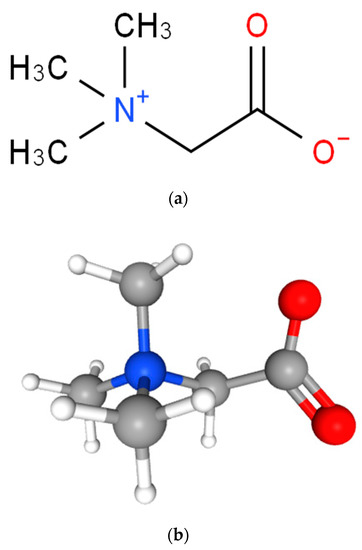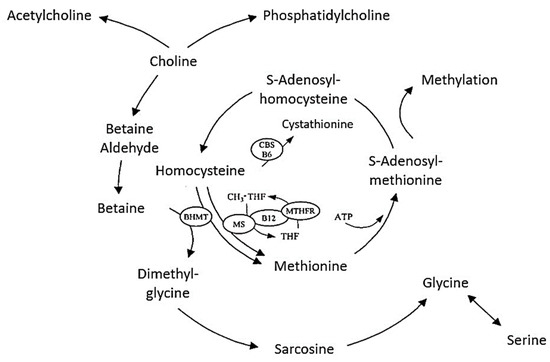You're using an outdated browser. Please upgrade to a modern browser for the best experience.
Please note this is a comparison between Version 1 by João Miguel Ferreira Rocha and Version 2 by Rita Xu.
Betaine is a non-essential amino acid with proven functional properties and underutilized potential. The most common dietary sources of betaine are beets, spinach, and whole grains. Whole grains—such as quinoa, wheat and oat brans, brown rice, barley, etc.—are generally considered rich sources of betaine. This valuable compound has gained popularity as an ingredient in novel and functional foods due to the demonstrated health benefits that it may provide.
- betaine
- metabolic pathways
- disease prevention
- food sources
1. Introduction
Betaine (trimethylglycine) is a natural product. It is a glycine derivatized by three extra methyl groups. Its chemical structural formula in 2D and 3D forms is represented in Figure 1. It is a stable and harmless natural constituent that exists in plants, animals, and microorganisms. It was reported that betaine is naturally present in beets, spinach, wheat bran, wheat germ, and aquatic invertebrates [1][2][1,2]. Betaine is endogenously produced via choline metabolism or exogenously ingested through dietary intake [3]. Either ingested as a dietary supplement or from food, betaine has a similar bioavailability, being broken down to dimethylglycine and lastly to sarcosine in the mitochondria of kidney and liver cells [4].

Figure 1. Structural formulae of betaine: (a) 2D-structure; and (b) 3D-structure.
In the United States of America (USA), betaine is generally recognized as a safe ingredient, that is, a GRAS (Generally Recognized as Safe) ingredient, while in Europe it has approval for use in food from the European Commission (EC) [5][7], which allows the safe use of betaine in food in an amount of at least 500 mg per food serving. The above-mentioned health approval is associated with betaine’s contribution to the methionine cycle. Commercial betaine is available in three different forms: natural anhydrous betaine; synthetic anhydrous betaine; and betaine hydrochloride [5][7]. For secondary industries, betaine can be produced by chemical synthesis or by relatively expensive isolation from sugarbeets or byproducts of beet processing. Natural betaine has superior functional properties compared to its synthetic analogue, and its use is preferred by the pharmaceutical, cosmetic, and healthcare industries [6][7][8][9][8,9,10,11].
One of the main roles of betaine is to help regulate homocysteine levels in the blood [10][12]. Homocysteine is an amino acid that, when present in high levels, has been linked to a higher risk of heart disease, strokes, and other health problems. Betaine helps to convert homocysteine into other beneficial substances, thus helping to maintain healthy levels of this amino acid in the blood [11][12][13,14]. However, it was reported that betaine might have a harmful impact on blood lipids. Zawieja et al. [13][15] performed a meta-analysis on the impacts of betaine supplementation at a daily amount of at least 4 g on blood lipid status in adults. No significant impact was found for triglycerides, high-density lipoprotein (HDL) and low-density lipoprotein (LDL) cholesterol, or plasma total cholesterol. Supplementation with 4 g/d of betaine for 6 weeks could relatively increase plasma total cholesterol, which is important for cardiovascular health. Ashtary-Larky et al. [14][16] also carried out a meta-analysis on the impacts of betaine supplementation on cardiovascular illness indicators. They reported that supplementation with betaine at doses of 4 g/d might cause harmful effects on the lipid profiles of people with health disorders. On the other hand, supplementation with less than 4 g/d of betaine generated beneficial reductions in homocysteine levels. These findings indicate that a desirable quantity of betaine supplementation is below 4 g/d.
Betaine has also been shown to have potential benefits for exercise performance and muscle strength. Some studies have suggested that betaine supplementation may improve endurance, reduce fatigue, and enhance muscle power and strength [15][17]. In addition, betaine has been investigated for its potential role in supporting liver function and protecting against liver damage, as well as for its anti-inflammatory and antioxidant properties [11][16][13,18]. Overall, betaine is a compound with a range of potential health benefits, although further research is required to fully understand its mechanisms of action and effectiveness in various contexts.
Furthermore, betaine has been employed as a feed additive in pig and poultry rations since it is regarded as a cheap alternative feed supplement for improving nutrient utilization [17][19]. Betaine is generated by choline oxidation or delivered through diet in the animal organism. Over the past years, many studies have evaluated the impacts of betaine on various animal species. Betaine plays a role in the transmethylation reaction for the synthesis of some active constituents, such as carnitine, creatine, etc., as well as in the higher usage of nutrients and the digestibility and bioavailability of methionine. Enhancing immune status and decreasing heat or oxidative stress are also considered significant functions of betaine [18][20]. Most of the published research has been focused on the growth-stimulating, higher milk-yielding, carcass-modifying, immune-boosting, and stress-dropping properties of betaine in various species [19][20][21][21,22,23].
2. Metabolism and Physiology
In mammals, betaine plays three important metabolic and physiological roles: (i) it is an organic osmolyte, which helps to maintain normal cell volume under osmotic stress and can accumulate to molar concentrations; (ii) it provides protection against protein denaturation, thus being called a ‘chemical chaperone’; and (iii) besides methylfolate, it is the only molecule that provides methyl groups for homocysteine remethylation [22][23][24][25][27,28,29,30]. Besides mammals, cellular uptake of betaine occurs in various other organisms, such as bacteria and invertebrates. Belonging to the chemical class of amino acids, betaine is mainly transported with the aid of γ-aminobutyric acid [26][31]. Studies performed on animals have shown rapid absorption of betaine after a meal in the small intestine via the duodenum [27][32]. Studies on humans have shown rapid absorption and distribution of betaine within 1–2 h after ingestion. The constant concentration of betaine in human serum ranges from 20 to 70 µmol/L. According to Schwahn et al. [25][30], rapid absorption and distribution of betaine were found both in healthy subjects and patients with homocystinuria, with a maximum concentration of 0.94 mmol/L after 0.90 h and an elimination half-life of 14.38 h. Distribution and elimination kinetics in homocystinuric patients appear to be accelerated. Even at high doses of 100 mg per kg of human weight, betaine is mostly used up through metabolic pathways and not excretion. However, betaine can be present in the urine of individuals with kidney disorders and diabetes. Subacute studies in rats have shown that betaine is not toxic when added at 0–5% of the total diet. However, due to large intakes, the ratio of red blood cells could be slightly disturbed. Many authors suggest that the maximum daily intake of betaine is 9–15 g, with 20 g being the maximum [25][28][29][30,33,34]. The fundamental role of betaine in microorganisms and plant cells is cell protection from possible inactivation, which may occur due to osmotic stress [30][35]. Exposure of plants to hostile environmental conditions, such as drought, high salinity, and unfavorable temperatures, leads to increased betaine synthesis in cell mitochondria [31][36]. Betaine can fulfill its role as an osmoregulator only when it is not catabolized. Modulation of water content and cell volume is of crucial importance for living organisms. Cells have the ability to adapt to varying degrees of osmotic pressure by accumulating inorganic ions of low molecular weight (such as sodium, potassium, and chlorine ions) and organic osmoregulators (such as methylamines, amino acids, and sugar alcohols). The role of inorganic ions in osmoregulation is limited because their higher concentrations could affect protein structure and thus enzyme functions [32][33][37,38]. Betaine’s osmolytic action is the result of a dipolar structure and a good solubility in water, whereby, along with the other organic osmolytes, it demonstrates a lower degree of interaction with enzyme functions and metabolic processes in cells [34][39]. Studies have shown that betaine has a very low potential to bind to the protein surface, thereby allowing cells to control the water surface tension without affecting lipase stabilization [35][40]. A cytosolic methyltransferase enzyme, betaine-homocysteine S-methyltransferase, which uses betaine as the methyl donor for the remethylation of homocysteine to form methionine and dimethylglycine, is likely to help keep the cellular osmotic equilibrium by maintaining the regular betaine concentration. Its inhibition reduces betaine degradation [25][36][30,41]. Betaine plays its primary role as an osmolyte in the kidney tissue, thus protecting the mammalian kidney medulla cells from osmotic stress and enabling the control of the concentration gradient and the accumulation of metabolic waste products in the urine [25][31][37][30,36,42]. It can accumulate in the kidneys of humans, protecting the cells from the high concentration of electrolytes and urea. Furthermore, it can regulate the water balance and movement through the epithelial tissue [38][43]. Thus, betaine increases water retention in cells by replacing inorganic salts and protecting intracellular enzymes from osmotic pressure or temperature-induced inactivation [36][39][41,44]. For example, when spinach is grown on soil with high salinity, betaine accumulates in the chloroplast and prevents water from leaking out of the cells due to the increased osmotic pressure. Mitochondria in salmon liver cells adsorb betaine when exposed to increased osmotic pressure, thus allowing the body to use less energy to maintain the required amount of water in cells. For this reason, betaine is being added as an osmoregulator to ponds to protect fish when moving through water of different salinity degrees [31][36]. As already mentioned above, betaine plays its second major role in methionine metabolism by converting and detoxifying homocysteine to methionine in the human liver and kidneys, acting as a methyl group donor [40][41][45,46]. Even a slightly elevated level of homocysteine in the blood could be considered a biomarker of increased risk of cardiovascular, cerebral, and peripheral vascular diseases, neurodegenerative disorders, and cognitive decline [42][43][47,48]. Moreover, higher homocysteine concentrations have been associated with low concentrations of B vitamins, such as folate and vitamins B-12 and B-6, which are involved with a one-carbon metabolism, pointing to its disturbance [44][49]. Research has proven that betaine intake can contribute to the lowering of circulating homocysteine levels in patients with homocystinuria and chronic renal failure, but even in healthy subjects [45][46][50,51]. The association between dietary intakes of betaine and the concentration of homocysteine has been assessed by Chiuve et al. [47][52]. A cross-sectional analysis of 1477 women proved that total betaine intake, together with its precursor choline, was inversely associated with plasma homocysteine levels. Furthermore, the authors concluded that the remethylation of homocysteine may be more dependent on the betaine pathway when other methyl sources are low, which might be a result of either inadequate folate intake or heavier alcohol consumption [47][52]. According to the study of Lee et al. [44][49], performed on food-frequency questionnaires on 1325 male and 1407 female participants in the USA, a higher choline-plus-betaine intake managed to decrease the concentration of post-methionine-load homocysteine. Betaine and choline intakes were, therefore, associated with both fasting and post-methionine-load total homocysteine concentrations, especially in participants with low folate and vitamin B-12 status [44][49]. Since betaine is found in high amounts in wheat aleurone, research by Price et al. [37][42] investigated the impact of a diet rich in whole-grain foods on 79 healthy participants over four weeks. The results showed a significant increase in plasma betaine concentrations, as well as dimethylglycine and methionine as products of betaine-mediated homocysteine remethylation, and a significant decrease in plasma homocysteine and LDL cholesterol levels. No significant effects on plasma choline or B vitamins (folate, riboflavin, and vitamin B-6) were thereby observed [37][42]. Betaine could be produced in the human body by a series of enzymatic reactions that mainly occur in the mitochondrial cells of the liver and kidneys. These transmethylation reactions imply the transfer of methyl groups via the methionine cycle in vital biological processes, as shown in Figure 2 [48][53].
Figure 2. Methionine metabolic pathway.
